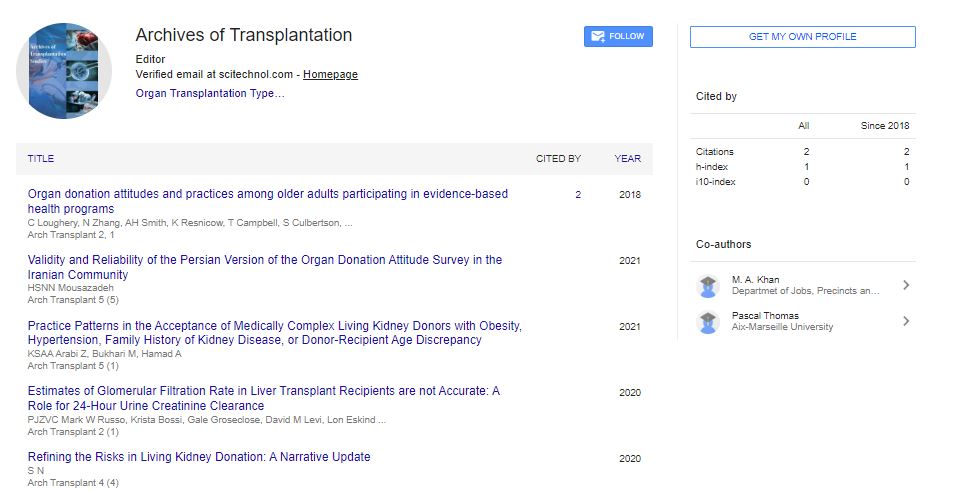Commentary, Arch Transplant Vol: 7 Issue: 3
Assessment of Donor-Derived Cell-Free DNA in the Diagnosis of Acute Rejection in Heart Transplant Recipients
Anna Chialo*
1Department of Medicine, University of Washington School of Medicine, Seattle, USA
*Corresponding Author: Anna Chialo,
Department of Medicine, University of
Washington School of Medicine, Seattle, USA
E-mail: annachao95@gmail.com
Received date: 02 September, 2023, Manuscript No. AT-23-116164;
Editor assigned date: 04 September, 2023, PreQC No AT-23-116164(PQ);
Reviewed date: 18 September, 2023, QC No AT-23-116164;
Revised date: 25 September, 2023, Manuscript No AT-23-116164(R);
Published date: 05 October, 2023, DOI: 10.4172/AT.1000147.
Citation: Chialo A (2023) Assessment of Donor-Derived Cell-Free DNA in the Diagnosis of Acute Rejection in Heart Transplant Recipients. Arch Transplant 7:3.
Abstract
Description
Heart transplantation is a life-saving therapy for end-stage heart disease, but the risk of acute rejection remains a challenge in managing transplant recipients. Traditional diagnostic methods have limitations in detecting rejection early. Donor-Derived Cell-Free Deoxyribonucleic Acid (dd-cfDNA) has emerged as a promising biomarker for the non-invasive assessment of acute rejection. The current state of acute rejection diagnosis in heart transplant recipients and evaluates the role of dd-cfDNA in improving early detection and patient outcomes.
Heart transplantation is the definitive treatment for end-stage heart disease, offering improved quality of life and survival. However, the risk of acute rejection remains a significant concern, as early detection is important for timely intervention and improved outcomes. Conventional diagnostic methods, such as Endomyocardial Biopsy (EMB), have limitations, including invasiveness, sampling errors, and the risk of complications. Donor-derived cell-free DNA (dd-cfDNA) has emerged as a novel and non-invasive biomarker that holds the transforming the diagnosis of acute rejection in heart transplant recipients.
Acute rejection diagnosis in heart transplantation
The diagnosis of acute rejection traditionally relies on EMB, which involves the sampling of myocardial tissue for histopathological assessment. Despite its historical significance, EMB has limitations, including sampling variability, procedure-related complications, and the inability to detect early rejection. The need for alternative noninvasive methods has driven research into novel biomarkers like ddcfDNA.
Donor-derived cell-free DNA
dd-cfDNA is a promising biomarker for acute rejection diagnosis. It represents small fragments of DNA released into the recipient's bloodstream by the transplanted heart. When the immune system attacks the transplanted organ, it releases dd-cfDNA, which can be quantified and analyzed. dd-cfDNA levels tend to increase during episodes of acute rejection, making it a potentially sensitive and specific marker for early detection.
Several methods, including Next-Generation Sequencing (NGS) and Polymerase Chain Reaction (PCR), have been developed to quantify dd-cfDNA. These techniques offer a non-invasive and quantitative assessment of rejection status, allowing for early intervention and potentially improving patient outcomes.
Clinical utility of dd-cfDNA
Recent studies have shown promising results regarding the clinical utility of dd-cfDNA in diagnosing acute rejection. Elevated dd-cfDNA levels have been associated with acute rejection episodes, allowing for earlier detection compared to EMB. Early intervention based on ddcfDNA results may lead to more effective rejection management and improved graft survival.
Additionally, dd-cfDNA has the potential to reduce the need for frequent and invasive EMB procedures, enhancing patient comfort and reducing healthcare costs. However, further validation and standardization of dd-cfDNA testing protocols are essential to ensure its widespread clinical adoption.
Challenges and future directions
Despite its potential, several challenges must be addressed before dd-cfDNA can become a routine diagnostic tool for acute rejection in heart transplantation. These challenges include establishing standardized dd-cfDNA quantification methods, defining clinically relevant dd-cfDNA threshold levels, and addressing potential confounding factors.
Future research should focus on large-scale multicenter studies to validate the sensitivity and specificity of dd-cfDNA in different patient populations. Additionally, efforts to optimize testing protocols, improve cost-effectiveness, and ensure insurance coverage will be vital for the integration of dd-cfDNA into routine clinical practice.
Conclusion
Donor-derived cell-free DNA represent as a key biomarker for the non-invasive diagnosis of acute rejection in heart transplant recipients. Its ability to provide early detection and potentially reduce the need for invasive procedures like EMB makes it an attractive option for improving patient care. However, further research and validation are necessary to establish standardized protocols and threshold levels. The integration of dd-cfDNA into routine clinical practice has the potential to enhance the management of acute rejection, ultimately improving graft survival and patient outcomes in heart transplantation.
 Spanish
Spanish  Chinese
Chinese  Russian
Russian  German
German  French
French  Japanese
Japanese  Portuguese
Portuguese  Hindi
Hindi 